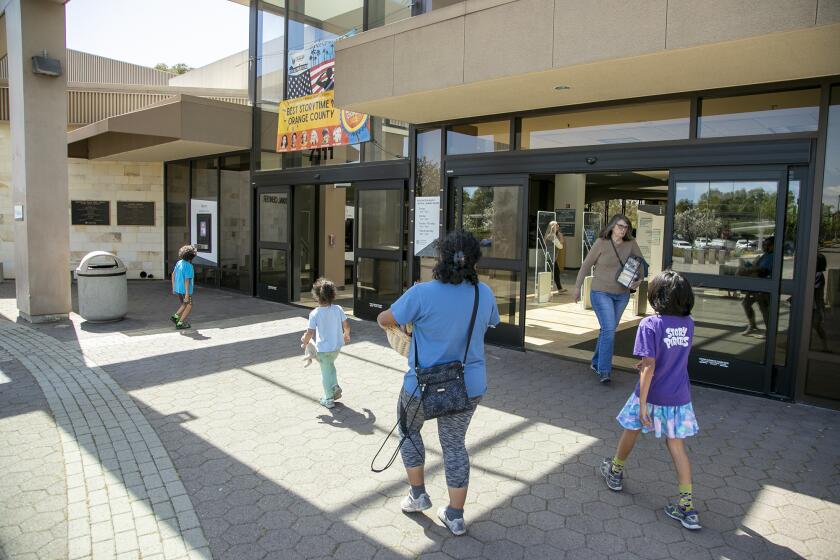Column: It’s time to invest in foreign-language instruction
- Share via
While traveling abroad earlier this summer, I was struck — as I always am while visiting foreign lands — by the impressive language skills of citizens of other countries.
From waiters to hotel clerks, tour guides to teachers, they all appeared to glide effortlessly from their native tongues to English to other foreign languages, while I ignorantly gaped at their fluency.
And once again, I shook my head in dismay over the fact that linguistics education in the United States is abysmal.
Actually, it’s worse than that. Foreign language instruction has never been our strong suit. But it’s been declining from our previous subpar levels, and that’s a troubling trend that will likely have serious economic, social and political consequences.
Last year, the National K-12 Foreign Language Enrollment Survey, sponsored by the U.S. Department of Defense, found that only 1 in 5 students is enrolled in a world language or American Sign Language. At the college level, enrollment in foreign languages has been undergoing a years-long decline.
The backward slide is a problem of our own making. Indeed, there was a time when we began a push to place greater emphasis on foreign-language instruction.
As far back as the late 1950s and 1960s, increased federal funding was made available to enhance foreign-language education. In the 1980s, successful dual-language immersion programs began to emerge, enabling instructors to teach various subjects in other languages.
But even then, such instruction never reached the point of being widely available to all students. Then, in 2002, with advent of the No Child Left Behind educational reforms, foreign language education took a big hit as the standardized testing required in English and math resulted in foreign-language programs being further deemphasized.
Budgets, curriculum and training were adjusted according to the appalling logic that if we don’t test it, why bother teaching it.
Now we’re in danger of suffering the ramifications of being so shortsighted.
Another study released last year by the American Academy of Arts & Sciences concluded that the United States could face severe repercussions in our increasingly globalized economy because of our lack of foreign-language skills.
Keep in mind that while we’ve been backsliding, other countries have boosted their linguistics education. In most European countries, students are required to learn another language besides their native tongue. Some even mandate two additional languages.
In China right now, hundreds of millions of students are learning to speak and read in English.
And many Latin American nations, recognizing the need to be globally competitive, have rolled out reforms in recent years that prioritize foreign-language instruction.
Meanwhile, here in the United States, the situation is so bad that 44 states report they can’t find enough foreign-language teachers to meet the anemic demand, according to the American Academy report.
The effects of this failure aren’t just felt on a macro level. Studies have shown that foreign-language skills improve an individual’s hiring prospects, increase their pay levels and contribute to positive cognitive development. The vast majority of our kids are missing out on these benefits.
Fixing this glaring shortcoming in our education system won’t be easy.
In part that’s because of the way education is structured in this country. Most educational policy is set not by federal mandate, but at the state and local level, which results in wide geographic disparities.
It will take a state-by-state, district-by-district effort to place foreign-language instruction higher on the list of priorities. And even then questions surrounding funding will likely be hotly contested. Where to find qualified teachers will also be problematic.
Complicating the picture is the fact that foreign-language education, if it’s to have any hope of being effective, must begin early — the earlier the better.
Research tells us that children must begin learning a foreign language by age 10 in order to achieve complete fluency. After the age 17 or 18, the ability to become merely proficient precipitously drops.
Some reformers advocate a return to dual-language immersion programs, but this time we should commit to them in a big way. They argue that such programs are an effective, efficient means of incorporating foreign-language instruction into other coursework, making separate language classes largely obsolete and ensuring that all students are offered the opportunity to become multilingual.
I don’t know if that’s the best method, or if there are other programs that could be used instead of, or in addition to, dual-language immersion. I leave it to the educational gurus to figure out out the details.
But regardless of the difficulties — funding issues, a dearth of qualified teachers, a lack of political and institutional will — we can and must do something about this problem, and we should do it quickly and decisively.
Right now, we are failing to prepare today’s students for a globalized economy, and the costs of that failure will only increase as time goes on.
If we are to have any hope of engaging and competing internationally well into the future, we must give our kids the tools they need. Let’s commit to making foreign language instruction front and center in every child’s education.
Patrice Apodaca is a former Newport-Mesa public school parent and former Los Angeles Times staff writer. She lives in Newport Beach.
All the latest on Orange County from Orange County.
Get our free TimesOC newsletter.
You may occasionally receive promotional content from the Daily Pilot.




